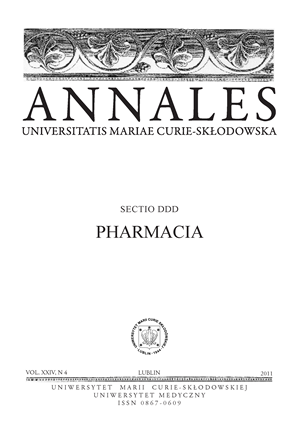Analysis of expression profile of genes encoding cellular receptor proteins in endometrial cancer
DOI:
https://doi.org/10.12923/Keywords:
Endometrial cancer, MacroArray Technique, gene expression profileAbstract
Endometrial cancer (EC) is one of the most common gynaecological malignancy. Unfortunatelly, molecular pathogenesis of this neoplasm remains poorly understood. More than 90% od EC cases are sporadic and they can be divided into two main subgroups. The first group consists of oestrogen-related tumours that occur in pre and post-menopausal women and are frequently proceded by endometrial hyperplasia. These tumours are usually associated with abnormalities of DNA-mismatch repair genes, k-ras, PTEN and beta-catenin. The second group consists of tumours that occurs mainly in post-menopausal women and which are usually not related to oestrogen. These tumours are characterized by abnormalities of p53 and HER2/neu. The aim of our study was to profile expression of cellular receptor genes to candidate those typical for tumor grade or clinical stage by the mean of macroArray technique.
Based on Kruskal-Wilis test we pointed out nine genes encoding cellular receptor proteins showing statistically significant over or under-expression (4 and 5 genes respectively) depending tumor grade. The analysis of statistic dependences between gene expression profiles and clinical stage of tumor pointed out 15 genes encoding cellular receptor proteins the expressions of which were altered showing statistical significance for different clinical stages. It is worthy to note that understanding of mechanisms underlying alternation of genes expression is a real key to establish new prognostic factors and tailored therapy for endometrial cancer.
References
1. Beviglia L. et al: Expression of the c-Met/HGF receptor in human breast carcinoma: correlation with tumor progression. Int J Cancer 74, 301, 1997.
2. Halperin R. et al: Comparative immunohistochemical study of endometrioid and serous papillary carcinoma of endometrium. Eur J Gynaecol Oncol. 22, 122, 2001.
3. Hecht J.L., Mutter G.L.: Molecular and pathologic aspects of endometrial carcinogenesis. JCO 24, 4783, 2006.
4. MacDonald N.D. et al: Frequency and prognostic impact of microsatelite instability in a large population-based study of endometrial carcinomas. Cancer Res 60, 1750, 2000.
5. Matias-Guiu X. et al: Molecular pathology of endometrial hyperplasia and carcinoma. Hum Pathol. 32, 569, 2001.
6. Mutter GL. et al: Altered PTEN expression as a diagnostic marker for the earliest endometrial precancers. J Natl Cancer Inst. 92, 924, 2000.
7. Natali P.G. et al: Overexpression of the met/ HGF receptor in renal cell carcinomas. Int J Cancer 69, 212, 1996.
8. Otte J.M. et al.: Functional expression of HGF and its receptor in human colorectal cancer. Digestion 61, 237, 2000.
9. Park Y.H. et al: Effects of hepatocyte growth factor on the expression of matrix metalloproteinases and their tissue inhibitors during the endometrial cancer invasion in a three-dimensional coculture. Int J Gynecol Cancer 13, 53, 2003.
10. Rolitsky C.D. et al: HER2/neu amplification and overexpression in endometrial carcinoma. Int J Gynecol Pathol. 18, 138, 1999.
11. Ryan A.J. et al: Endometrial cancer. Cell Tissue Res. 322, 53, 2005.
12. Seagusa M. et al: Beta-catenin mutations and aberrant nuclear expression during endometrial tumorigenesis. Br J Cancer, 84, 209, 2001.
13. Tanaka T. et al: Suppressed apoptotic susceptibility in human endometrial epithelial cells pretreated with hepatocyte growth factor. Clin Exp Obstet Gynecol 25, 125, 1998.
14. Tashiro H. et al: p53 gene mutations are common in uterine serous carcinoma and occur early in their pathogenesis. Am J Pathol. 150, 177, 1997.
15. Toyoki H. et al: Clinical implication of expression of cyclooxygenase-2 related to angiogenesis in uterine endometrial cancers. Ann Oncol. 16, 51, 2005.
16. Wagatsuma S. et al: Tumor angiogenesis, hepatocyte growth factor, and c-Met expression in endometrial carcinoma. Cancer 82, 520, 1998.
Downloads
Published
Issue
Section
License
Copyright (c) 2011 Authors

This work is licensed under a Creative Commons Attribution-NonCommercial-NoDerivatives 3.0 Unported License.


